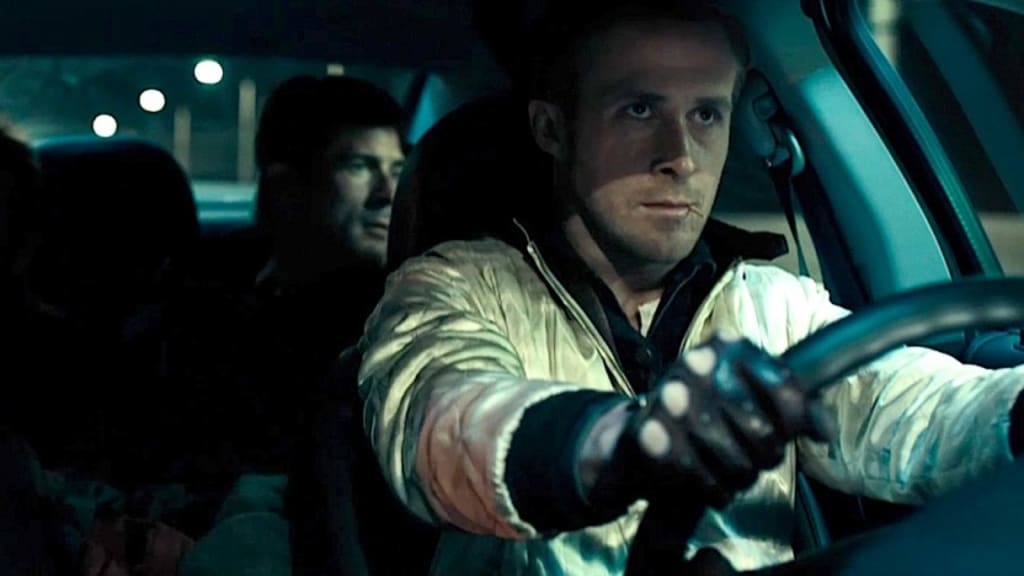Late Reviews: 'Drive'
A continuous series about movies, music, books, and other arts

What drives a story?
Puns asides, people find different stories compelling. Some prefer the drama that unfolds in lavish period pieces, while others prefer the anxiety of a horror story. The viewers ask questions left and right: will the hero/heroine escape with their lives? Will they end up with the love of their life? Who's on their side? Who or what stands in their way?
Regardless of genre, at the core nature of stories (specifically compelling stories) is a relatable protagonist. The protagonist is the heroine or hero of the film. Some have off-the-wall personalities, and come alive with every step we see, read, visualize, etc. Protagonists like Spider-man, Rocky, or whoever, all have distinct personalities. This helps them stand out from the rest of the cast of characters that fall around them.
There are times, however, in which our protagonists don't really have anything unique about them other than how they look. This helps audiences relate to the characters even more, because it allows them to apply our own personalities, or what we deem "cool" personalities. Viewers connect with certain characters with qualities that they can feel and relate to.
Video games, specifically first-person shooters, along with books, are frequently guilty of this. This would be called "the silent protagonist" in literary terms. Film, at times, adopts some of these unique qualities of this type of character building.
This is where Drive, directed by Nicholas Winding Refn, takes the qualities and blends them in a way in which it provides a different perspective for the audience members. In Drive, the film follows a man who is a stunt driver for movies, and a mechanic during the day, yet acts as a getaway driver for criminals at night. The driver's world is turned upside down when a new neighbor moves in to the apartment next to him with her son. The normally reserved driver finds himself opening up as he spends more and more time with them. The neighbor's husband arrives from jail, and finds himself in debt with some bad people, causing the driver to get involved.
Aside from the beginning of the film, the driver rarely speaks more than a couple lines. Played by Ryan Gosling, the film starts off with a pan shot, moving up from plan blueprints to our protagonist staring at the LA nighttime. Refraining from spoilers, the camera slowly moves in, and shows the driver's reflection, distorting the viewers perception of not only the character, but Ryan Gosling himself.
The film goes a short while to set up the driver as a man with no morals, but juxtaposes that. As the film progresses, the driver gradually connects with Irene and her son Benicio. It further complicates his character as the driver conducts acts of violence later in the film (for good reason of course). All this together intertwines to make the driver into a complete and living character
Along with the amazing set-up of our main protagonist, the camera work, in conjunction with the editing is phenomenal. There is a unique mix of shots. Different types of shots imply different types of things. Whether it is trying to display a tone, a mood, or a relationship between two characters.
For example, there will be instances of tracking shots (shots in which the camera follows the characters) of the driver talking to Irene, heading up to their apartment floor. For the next shot, the framing will be a little off. A reflection of the driver is shown while the camera is focused on Irene. It indicates a sense of disconnection, yet the character is waiting for that to be changed. It'll then cut to a wide angle shot showing Irene's son Benicio playing and interacting with the driver.
From shots with the characters, the lighting makes what is going in the scenes stand out even more. During the night, lights from buildings, signs, etc. wash over the driver's face. It again distorts the clarity of the character, somehow questioning his legitimacy to the audience. In the afternoon scenes, hues of orange and yellow rest softly on the characters, showing a different kind of LA altogether. In the day, characters are clear, yet they cover themselves up with sunglasses, hiding their face from other characters. Shots create subtle dynamics with characters that normally wouldn't be there if framed differently.
In the action/driving sequences, the cinematography truly stands out. There will be sharp cuts from the driver's point of view to under the car to the passenger during a chase scene. It blends in beautifully, and somehow makes it more realistic. These up close and personal shots give the audience members a chance to connect with the driver as he drives for his life.
In addition to all this, Drive's in-film soundtrack is as good as any film. A soft droning synth plays during the opening scene of the film, and continues as Kavinky's "Nightcall" opens along with the title cards. The closing song's accurately titled, "A Real Hero" by College Youth, and it plays right into the hands of the 80s-themed music.
Throughout the film, we see genre blending themes and qualities mixed in to make out the core of Drive. The shady protagonist with a soft spot for a special woman deriving from film noir, the synth-driven soundtrack of a classic 80s film, and some of the driving/action sequences of a Hollywood blockbuster.
Drive does not belong in one steady genre anyway. It gathers too many ideas from too many places. Unlike other films, however, it finds its own balance. It provides a unique experience for anyone looking to enjoy something surreal and thrilling at the same time.
Rating: 9/10
About the Creator
George Gomez
Screenwriter first, Mexican-American second, Trying to change the world with my words third.
www.gutsfilms.com






Comments
There are no comments for this story
Be the first to respond and start the conversation.